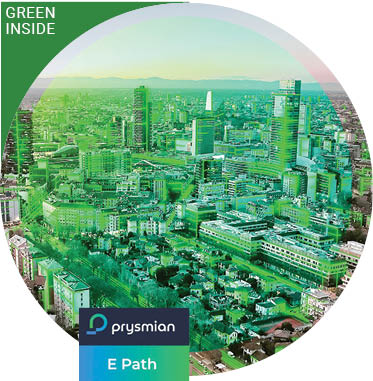EPath®by Prysmian & Associated Cables is the company’s Environmental Product Declaration program, a label that certifies the environmental impact of cables across their life cycle. To be EPath-labelled, each cable family has to pass a rating process based on the carbon footprint; substances of very high concern; recyclability/circularity; recycling input rate; environmental benefits; and cable transmission efficiency. In an exclusive chat with Wire & Cable India, Mr. Benoit Lecuyer, CEO, Prysmian India & Associates Cables, shares how the implementation of EPath aims to facilitate the identification of eco-friendly products and provide high-quality, reliable, and sustainable cables that meet customer demands.

Energy and telecom cables are widely used in several industrial and commercial environments in our daily lives. To meet the increasing production demand, factories output increase, entailing high amounts of carbon emissions released. To prevent this, Prysmian and Associated Cables make great efforts and define initiatives to limit the emissions arising at all stages- from the production of the raw materials, manufacturing of cables, to the testing process of the produced cables. Accordingly, we have developed the EPath label system to evaluate the contribution of cables in terms of the impact of climate change, and to offer environmentally friendly solutions.
The EPD (Environmental Product Declaration) or EPath label brings strategic, environmental, and market benefits. Selected cables bear a green label that can be approved in the cable industry. Prysmian and Associated Cables bearing EPath label are based on measurable and accepted sustainability criteria that are compatible with the European Union Label Regulation No. 66/2010, or the Indian standards on the principles of sustainability, reliability, and quality.
The classification system is based on criteria that are easy to apply, measurable, reliable, and recognized. The cable’s EPath label goes through a rating process based on six different criteria that examine carbon footprint, recyclability / circularity, recycling input rate, environmental benefits, cable transmission efficiency, and the presence of environmentally hazardous substances.
Watch: Top Cable Companies in India
The ‘Carbon Footprint’ criterion aims to determine the effects of climate change resulting from the life cycle of cables. Based on ISO 14067:2018 – Product Carbon Footprint Standard, the carbon footprint created by the product throughout the product life cycle is calculated. ISO 14067:2018 – Product Carbon Footprint Standard, is a standard to provide reliability for calculating direct and indirect greenhouse gas emissions resulting from the production, transportation, disposal of the product and for determining the amount of reduction that can be done.
There should be no ‘Toxic or Environmentally Hazardous Substances’ in cables. Based on REACH and RoSH regulations, the presence of Carcinogenic, Mutagenic, Reprotoxic (CMR), and other toxic/environmentally hazardous substances in the cables are prevented. Within the scope of the REACH (Registration, Evaluation, Authorization, and Restriction of Chemicals) Regulation, companies producing or importing more than one ton of chemicals per year, must register such chemicals. On the other hand, RoHS (Restriction of Hazardous Substances Directive) restricts the use of some hazardous substances in the production of various electronic and electrical equipment.
The ‘Recyclability Criteria’ draws attention to the recycling potential of the materials used in cable production and the possibility of including the products in recycling and recovery processes at the end of their life. Recycling and reuse lead to various benefits, such as reducing raw material consumption and waste generation. The recyclability index is calculated for all materials in the final product delivered to the customer. Thus, it is aimed to use resources more efficiently and reduce environmental impact by focusing on the recycling and recovery of materials used in cables.
The ‘Recycling Input Rate’ represents the presence of recycled materials, both outsourced and internally reused, in making a cable. The ISO 15270:2008 standard is taken as a basis to evaluate this criterion. As an evaluation criterion, it is required that the product be optimally made of 10% recycled material. Recycling methods include the reintegration of recycled materials as secondary raw materials. This can be done in two ways- first, recycled material can be reused, possibly mixed with virgin raw material, to produce the same type of products that generate waste. Second, the recycled material is reused in the manufacture of different products that consist of the same materials. This emphasizes the circularity approach in the cable industry.
The ‘Environmental Benefits’ criteria result from the use of low-carbon products which are compliant with CPR (Construction Products Regulation). The EN 50575 standard, which is the extension of CPR in the cable industry, specifies which fire reaction performance must meet which criteria. It also requires fire performance declarations and CE-marking of cables used in buildings. Accordingly, the materials used in halogen-free cables do not contain any of the elements of fluorine, chlorine, bromine, and iodine and do not produce toxic and corrosive gases during fire that are harmful to the environment and human health. The environmental benefits criterion is evaluated based on the CPR class.
Also Read: Tunisie Cables Enhances Insulation Extrusion with Advanced Solutions from ZUMBACH Electronic AG
The ‘Cable Transmission Efficiency’ (performance) contributes to defining product sustainability. It relates to the losses occurring throughout its entire life cycle. The losses are largely due to the joule effect in the conductor during current transmission. While these losses are voltage drop in power cables, they may be related to the propagation or scattering of light within the core for fiber optic cables. To prevent such losses in cable projects, conductor cross-section calculation is one of the most important factors. Compared to the transmitted power, the lower the joule (J) losses, the higher is the efficiency and more sustainable is the performance. We endeavor to create measurable, environmentally friendly, best practices throughout the supply chain. We manufacture with a commitment to offer environmentally friendly cables to our customers.





